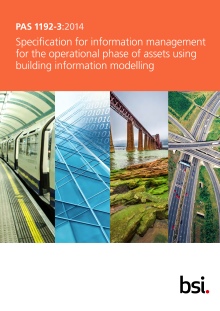BIM advances to the FM stage

BIM (building information modelling) has reached the operational phase of buildings with the publication of the latest PAS (publicly available specification). BSRIA’s Jo Harris explains the huge significance and potential of this stage.
The question on everybody’s lips is, ‘What can BIM do for me?’ If you are the operator or owner of assets, then the answer is actually quite a lot. With the UK Government pushing forward with Level 2 BIM on all its mandated construction projects by 2016, the industry is busy working out what that means for them. Facilities managers and their property management brothers and sisters are the groups that stand to benefit the most.
As everyone knows knowledge is power, and BIM is all about giving the recipient of the data generated by the process that knowledge. The information resulting from a BIM process becomes shared knowledge during a construction project that supports design decisions and allows visualisation and discussion with clients and their representatives. This process supports better decision-making about a facility from the earliest conceptual stages, through design and construction, and into its operational life; it will even support demolition.
Wikipedia has BIM defined as a process involving the generation and management of digital representations of physical and functional characteristics of places. Building information models (BIMs) are files that can be exchanged or networked to support decision-making.
There are many definitions of what BIM is, but at its core BIM is a managed approach to the collection and exploitation of information.
What BIM can offer the property management sector is:
• a method for organising and naming data;
• a method for housing data;
• a method for distributing data.
 |
| Fig. 1: How ISO 55000 describes the planning and implementation elements of an asset-management system |
Earlier this year the Government BIM task group redefined the scope for Level 2 BIM as having compliance with seven ‘components’ — the seven pillars of (BIM) wisdom if you like and as listed below.
• PAS 1192-2:2013 Specification for information management for the capital/delivery phase of construction projects using building information modelling.*
• PAS 1192-3:2014 Specification for information management for the operational phase of assets using building information modelling.*
• BIM Protocol.†
• GSL (Government Soft Landings).†
• BS 1192-4 — due for release summer 2014.
• Digital plan of work — due for release March 2015
• Classification — due for release March 2015
Of these seven components, four already exist. The latest of them (PAS 1192-3) has just been published by BSI. BS 1192-4 is due to be available in summer 2014, with the last two components being the subject of a Technology Strategy Board (research funding body) funded competition which should finish in March 2015.
PAS 1192-2 is aimed primarily at managing construction project information prior to it being handed over to the client, whereas PAS 1192-3 deals very specifically with the organisation and management of the information relating to an asset during its operational life.
PAS 1192-3 is an important document for the FM industry. It sets out the need for comprehensive and accurate information and is a great start to the in-use phase of an asset’s life, but the information needs to be maintained to be kept up to date. PAS 1192-3 describes the processes necessary to achieve this, resulting in an asset information model (AIM), a single information source that can be used as the basis for all asset related decision making.
Basically, BIM is all about the efficient use of information and data of assets or group of assets. This information and data created in a BIM project is gathered throughout the design and construction stages and then used as the basis for its on-going management. There are opportunities here for FMs to take a role in the project design process and inform the design team of what data is needed and in what format, to allow them to operate their building effectively.
To arrive at handover in a construction project with the best possible data set, the operational requirements must have been considered as part of the project briefing process. This allows the information being prepared throughout the procurement phases to be focused on adding maximum value to the operations process — providing what is required and in the right format. This must also satisfy the organisation’s organisational information requirements (OIR), as identified as part of its asset management plan. An asset management plan is discussed in detail in ‘PAS 55 Asset management’ and its equivalent ISO standard ISO 55000, recently published by BSI.
ISO 55000 is applicable to any organisation where physical assets are a key factor in achieving its business goals and describes the planning and implementation elements of an asset-management system (Fig. 1).ISO 55000 provides any asset owner with the help needed to plan asset management, the processes described within PAS 1192-3 are there to help you manage data when implementing the plan.
 |
| BIM has reached the operational phase of construction projects with the publication of PAS 1192-3. It can be freely downloaded from the PAS link below. |
It is worth pointing out that PAS 1192-3 not only deals with the management of information received as part of a new-build project. It also includes processes for managing information from other sources such as existing asset databases, routine maintenance tasks and one-off remedial works — all of which FMs are dealing with during the normal operational life of an asset.
So, when the organisation’s information requirements have been identified with the help of ISO 55000, PAS 1192-3 is used to manage the asset information. There are several ways in which this can help FMs in their daily activities.
• The first key point to appreciate is that, having gone through the verification and validation process described in PAS 1192-3, the FM now has an accurate and up-to-date asset information model (AIM).
• This information will be used as the information source for many other systems and activities, or linked enterprise systems, used as part of the daily operational activities such as CAFM, finance, IT support, building management and communications.
• The information can be used for planning not only regular activities, but also major works.
An accurate and up-to-date AIM can save significant effort currently required to verify the status of existing assets — including their quantity, location and condition — which may be needed to form the basis of new works.
There is a lot for FMs to get excited about with BIM, and it starts with having a robust process for organising the information which it makes available — the information which is key to everything the FM does.
Organised data about the building in turn provides accurate data for decision making and running buildings efficiently; one example is understand the control strategy for the BMS. Organised data can give a competitive advantage to any FM contractor that embraces BIM and offers the service of managing clients’ information of existing buildings data in line with the BIM process so that any future projects can feed into the existing information platform.
The information about assets can reduce maintenance costs, with better resource management and much improved decision making. There will be no need to refer to dusty out-of-date O&Ms for parts information; it will be at your fingertips in a digital environment.
CAFM system data population will no longer be a 3-monthly manual task but a one-day automated transfer of data from the BIM model to the CAFM system of your choice.
You don’t have to wait until you have a new building built to benefit from PAS 1192-3; the principles set out in PAS 1192-3 will help you start the journey and can take a progressive approach as you update your information about your existing properties. You just need to create the right environment for managing all the data about your properties.
PAS 1192-3 was project managed by BSI with BSRIA as the technical authors. For further information contact Jo Harris or John Sands at BSRIA.
*PAS 1102-2 and PAS 1192-3 are available as free downloads from the second link below.
†BIM protocol and GSL are available as a group of documents free to download at the third link below.








